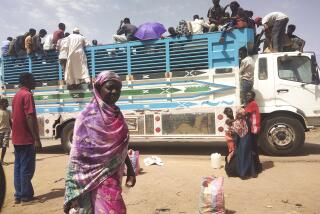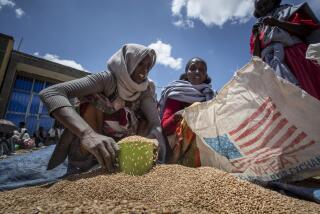Unpopular Food Sent to Thwart Somali Looting
WASHINGTON â Much of the U.S. food aid going to famine-ravaged Somalia consists of corn and sorghum, grains chosen because they are less likely to be stolen by roving bands of armed thugs since Somalis donât much like them, President Bushâs aid coordinator said Tuesday.
Andrew Natsios, assistant administrator of the Agency for International Development, said the grains are ideal for free food distribution because they are nutritious enough to alleviate hunger but are not popular enough to command high black-market prices.
He added that the aid will not cause Somali farmers to stop planting the grains, always a danger when food is given away, because neither crop is grown there anyway.
âWe must break the vicious cycle in Somalia where food equals money,â he said. âProviding more food . . . will not only make it more affordable, but it will also increase security.â
Natsios, who just returned from an inspection trip to Somalia, said the U.S. food airlift, which began last Friday, already has begun to ease the crisis, even though very little of the food has reached some critical areas. Food prices have declined, he said, and the flow of refugees to neighboring countries has dropped by 90%.
In Nairobi, Kenya, Panos Moumtzis, a spokesman for the U.N. High Commissioner for Refugees, confirmed the 90% decline in the flow of refugees, the Associated Press reported. He said that through August, an average of 1,000 refugees a day fled from Somalia to Kenya. But for the 10 days ending last Sunday, the number dipped to between 200 and 300 a day, and on Sunday it fell below 100 for the first time in almost two years.
News of the food aid was actually drawing Somali refugees and drought-stricken Ethiopians to Somalia from Ethiopia, Moumtzis said.
âWherever you put the food, you create a magnet with people running to it from either direction,â Moumtzis said.
In Rome on Monday, the United Nations announced plans to double its relief pledge to the Horn of Africa nation, from 76,000 tons of food to more than 145,000 tons worth about $26 million, according to the Associated Press.
Although Somali food production has been reduced by drought, the main cause of starvation in the northeast African nation is the violence that followed the collapse of the nationâs government. After the overthrow of dictator Mohamed Siad Barre last year, the country has been at the mercy of militias loyal to rival warlords and to free-lance thugs.
Tens of thousands of Somalis already have died from the fighting, starvation and disease, and relief organizations have been warning that up to 2 million out of a population of 6.5 million are at risk unless the food shortage is quickly alleviated.
Natsios said conditions remain desperate in much of the country. For instance, no food has reached the village of Baidoa because it is a center of warlord violence. He said the village has changed hands 10 times in the last year and that every time a new militia comes in, it steals all of the food that is available.
âOver the last several years, I have been witness to most of the major famines in the world, and I can tell you that what I saw in Baidoa, Somalia, a few days ago is the worst in terms of human suffering that I have seen anywhere in the world,â Natsios said.
The U.S. airlift is delivering food to the town of Belet Huen, where security is satisfactory. Conditions there, Natsios said, have improved sharply. He said that food prices dropped 25% in just one day, apparently because merchants, persuaded that the airlift would eventually take the profit out of hoarding, began to sell food that they had held off the market.
More to Read
Sign up for Essential California
The most important California stories and recommendations in your inbox every morning.
You may occasionally receive promotional content from the Los Angeles Times.










